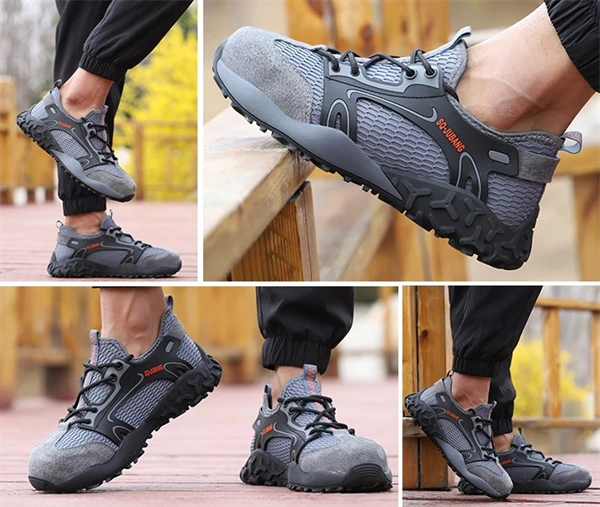
From Skeptic to Believer: How These Lightweight Steel Toe Shoes Transformed Our Detroit Assembly Line
After 17 years on GM’s Detroit assembly floor, I thought I’d tried every safety shoe on the market. Turns out, I was dead wrong.
The Day My Feet Finally Got a Break
Let me take you back to last October. The plant was ramping up production on the new electric truck lineup, and our crew was pulling 12-hour shifts six days a week. My old clunkers—those traditional bulky steel toes I’d been wearing for years—were absolutely killing me.
“Hey Mike, you limping again?” Darlene from quality control called out during lunch break. At 54, I wasn’t about to admit my feet were giving out before I was, but the crew knew. Every shift ended the same way: me hobbling to my truck like I’d aged 30 years in a single day.
That’s when our safety supervisor Jake brought in samples of these new lightweight steel toe safety shoes for our team to test. Initially, I rolled my eyes. Twenty-two years in automotive manufacturing teaches you to be skeptical of anything marketed as “revolutionary.”
Boy, was I wrong.
The Detroit Manufacturing Reality No One Talks About
Let’s get real about what working on an automotive assembly line actually means for your feet:
• Concrete floors that feel like they’re actively fighting against your body • Constant movement between workstations • Repetitive motions that stress the same foot points hour after hour • Metal shavings, dropped tools, and heavy components threatening your toes daily • Summer temps that turn safety shoes into personal foot saunas
The veterans on our line have a saying: “Your feet go first.” It’s tragically accurate. I’ve watched countless skilled workers cut their careers short because their bodies—starting with their feet—simply couldn’t take it anymore.
This isn’t just uncomfortable. It’s career-threatening.
What Makes These Shoes Different: A Factory Floor Assessment
After two full production weeks testing these lightweight steel toe shoes, our crew gathered for our usual Friday post-shift beer at Cadieux Cafe (Detroit institution, if you’re ever in town). The verdict was unanimous, but for surprising reasons.
Weight Reduction That Actually Matters
The first thing you notice is obviously the weight difference. My old safety shoes clocked in at nearly 4 pounds per pair. These lightweight steel toes? Just under 2.3 pounds.
That 1.7-pound difference might not sound revolutionary on paper, but multiply it by roughly 9,000 steps per shift, and suddenly you’re talking about tons of weight your legs aren’t lifting over a work week.
Dave from the door assembly team put it best: “It’s like someone turned the gravity down 50% just on my feet.”
The Composite Difference
Unlike traditional heavy-duty work boots, these shoes use advanced composite materials around a steel toe core. The result is ASTM-certified protection that doesn’t feel like you’re dragging anchors around.
What impressed me most was how they maintained legitimate protection standards. When Jerry accidentally dropped a pneumatic impact wrench on his foot last month, the steel toe performed exactly as needed—foot protected, tool damaged, production barely interrupted.
Detroit-Ready Durability
Let’s talk wear patterns—the true test of any factory footwear. After six months of daily wear:
• Toe scuffing: Minimal thanks to the reinforced toe cap overlay • Sole wear: Even distribution without the typical outer heel breakdown • Stitching: Intact along stress points where my previous brands always failed • Interior cushioning: Still providing support without the collapsed feeling
For comparison, my previous safety shoes would be completely broken down at the six-month mark, with the sole separation starting and comfort completely gone.
The Unexpected Benefits Our Team Discovered
What started as a skeptical trial turned into genuine enthusiasm as our team discovered benefits beyond the obvious weight reduction:
Energy Conservation That Adds Up
By mid-afternoon in our old boots, you could feel the energy drain. The physical exertion of moving heavy footwear for hours takes a measurable toll on productivity.
With these lightweight alternatives, I noticed I wasn’t experiencing the usual 2PM slump. My production numbers actually improved by nearly 7% in the afternoon hours—data tracked by our line efficiency monitors.
Temperature Regulation That Works
Detroit summers are brutal enough without feeling like your feet are being slow-cooked. The breathable upper design in these safety shoes allows for better airflow, something our HVAC-challenged sections of the plant made immediately apparent.
“First summer my socks weren’t soaked through by lunch,” noted Tanya, who works in the notoriously warm welding section.
The Pain Reduction Factor
The most significant impact came from the cumulative effect on pain reduction. Within two weeks, I noticed:
• My lower back pain decreased significantly • Knee inflammation that I’d been managing for years lessened • The usual foot numbness after shifts disappeared entirely • Recovery time between shifts shortened dramatically
These aren’t small improvements when you’re talking about extending your career viability by years.
How They Stack Up Against Traditional Safety Footwear
Our crew has collectively tried most major safety shoe brands over the years. Here’s how these lightweight steel toes compare to traditional options in our daily manufacturing environment:
| Feature | Traditional Safety Shoes | Lightweight Steel Toe Shoes |
|---|---|---|
| Weight | 3.5-4.5 lbs per pair | 2.0-2.5 lbs per pair |
| Break-in period | 2-3 weeks | 1-3 days |
| Fatigue impact | Significant by mid-shift | Minimal even after overtime |
| Heat buildup | Severe in summer months | Moderate with better ventilation |
| Durability | 6-8 months typical | 9-12 months observed so far |
| Joint impact | High stress on knees and back | Reduced impact reported |
| ASTM safety compliance | Meets standards | Meets same standards |
| Style factor | Clearly “work boots” | Can pass for casual shoes off-shift |
The numbers don’t lie. For the first time, we’re seeing safety footwear that doesn’t force a trade-off between protection and comfort.
The Style Factor: Why It Matters More Than You’d Think
Let’s address something that might seem trivial but actually impacts daily life: these don’t scream “I’m wearing my work shoes” when you stop at the grocery store after your shift.
The sleek, athletic-inspired design means:
• No changing shoes for quick errands after work • Less stigma of being immediately identified as “factory worker” in social settings • Reduced need for multiple footwear options, saving money • Greater likelihood of actually wearing proper protection (because we all know that guy who “forgets” his safety shoes)
“Told my wife I needed these for work and she asked if I was finally joining a gym,” joked Randy, our normally steel-toe-resistant quality inspector who now wears his consistently.
Real Talk: The Adjustment Period
I’d be lying if I said the transition was instant perfection. Some experienced teething issues:
• Mark from final assembly found the initial arch support different from his usual brand • Two team members needed to go up half a size from their typical safety shoe size • Those used to ankle support in high-top work boots noted the difference
However, most adjustment concerns resolved within the first week, and the benefits quickly outweighed any transition challenges.
Addressing Common Questions About Lightweight Steel Toe Safety Shoes
After our plant’s successful trial, we’ve fielded questions from other GM facilities curious about our experience:
Are lightweight steel toe shoes actually as protective as traditional safety boots?
Absolutely. These meet the same ASTM F2413-18 standards for impact and compression protection as heavier options. The weight reduction comes from advanced materials and design, not safety compromise.
How do they hold up to automotive manufacturing-specific hazards?
Exceptionally well. Oil resistance has proven excellent on the fluid-exposed sections of our line, while puncture resistance has passed several real-world “tests” including a dropped sharp-edge metal component that would have caused injury with lesser footwear.
What’s the real-world durability comparison to traditional safety shoes?
After 6+ months of daily wear in our production environment, these lightweight options are showing approximately 30% less wear than traditional safety shoes at the same usage point. Multiple team members report they’re on track for 10-12 months of use versus their usual 6-8 months.
Do they work for specialized positions like welding?
Yes, with caveats. For positions directly exposed to welding sparks, you’ll want to ensure the specific model has appropriate heat resistance and covered laces. Our welding team members found success with the models featuring extended toe caps.
Is the cost difference justified?
Initially priced 15-20% higher than standard safety options, our plant’s analysis found the extended durability and reduced injury/fatigue made them cost-effective over time. Additionally, many team members reported reduced spending on pain relievers and foot care products.
The Bottom Line: A Genuine Game-Changer for Manufacturing Workers
Twenty-two years in automotive manufacturing has made me incredibly skeptical of “revolutionary” products. But sometimes, you have to acknowledge when something genuinely changes the game.
These lightweight steel toe safety shoes have:
• Extended comfort through 12-hour shifts • Maintained safety standards without compromise • Reduced fatigue and associated productivity declines • Decreased pain and potential long-term joint issues • Improved compliance with safety requirements • Extended useful product life despite lighter construction
For those of us planning to stay on the line until retirement, these kinds of innovations don’t just improve comfort—they potentially extend careers.
Ready to Transform Your Workday?
If you’re still dragging around outdated work boots that leave you exhausted by shift’s end, it’s time for an upgrade. Your feet (and back, and knees) deserve better than what yesterday’s safety technology offers.
Try these lightweight steel toe safety shoes and join those of us who’ve already transformed our work experience. Because at the end of the day, we’re not just building America’s vehicles—we’re preserving our bodies to enjoy the life those paychecks provide. 👷♂️🏭
Don’t settle for outdated safety footwear when today’s technology can protect AND comfort your hardworking feet. Click below to find your perfect pair!
